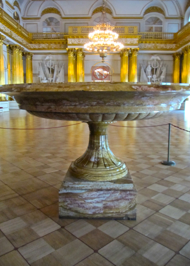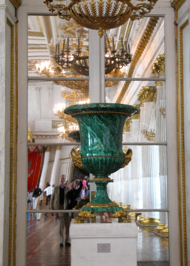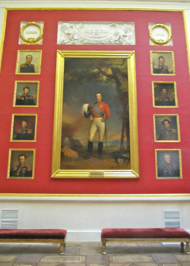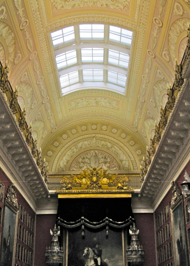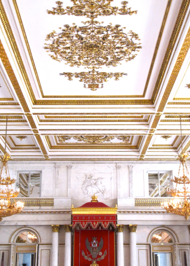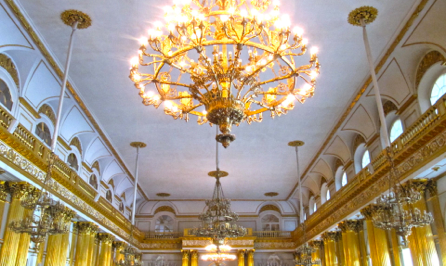The Winter Palace
Palace square & Neva river Front
St. Petersburg, russia


The Winter Palace
Palace square & Neva river Front
St. Petersburg, russia


The Winter Palace, official residence of the Russian monarchs from 1732 until 1912, was constructed on a a monumental scale that was intended to reflect the power and might of Imperial Russia*. This was not the modest palace of Peter the Great, founder of St. Petersburg, or of his immediate successor, his wife Tsaritsa Catherine I or their grandson, Tsar Peter II.
•Tsaritsa Anna (1730-1740): It was not until the reign of Tsaritsa Anna, who succeeded her nephew, Peter II, to the throne, that the Winter Palace began to take form. Anna quite loved St. Petersburg but rejected the former palaces. Instead, she re-established the Imperial Court at the Winter Palace in 1732 when she took up residence at the neighboring Apraskin Palace, incorporating neighboring houses, and commissioned Francesco Bartolomeo Rastrelli to completely rebuild this palace. The fourth and final Winter Palace is therefore not the palace of Peter the Great, but at its core is the palace of Admiral General Fyodor Maveyevich Apraksin. The 18th century was a period of great development in European royal architecture that had begun in the late 16th century, then accelerated as great classical palaces quickly replaced fortified castles throughout the more powerful European countries. One of the earliest examples is Louis XIV’s Versailles Palace, largely completed in 1710. Its size and splendor, Versailles set a new standard for palatial grandeur, and heightened the rivalry amongst the sovereigns of Europe. In the new Winter Palace in St. Petersburg, Anna replaced the plain furniture with furniture of mahogany and ebony and introduced an extravagant taste. Her dressing table was made of solid gold, and a stool of silver was studded with rubies.
•Tsaritsa Elizabeth (1741-1762) The Winter Palace became an ongoing project for the architect Rastrelli, not only during the reign of Anna, but later, during the reign of Tsaritsa Elizabeth, when the style of the palace became known as Elizabethan Baroque. The façade of the Winter Palace was completed during Elizabeth’s reign. The palace’s decoration in the form of statuary and opulent stucco work on the pediments above façades and windows has remained as finished during this time. The green and white palace is in the shape of an elongated rectangle, and its principal facade now measured 250 meters/820 feet long and 30 meters/100 feet high, facing the Neva River, accessible and visible to the public. The ground floor of the palace contained mostly bureaucratic and domestic offices. The first floor of the, the piano nobile, is distinguished by windows taller than those of the floors above or below. Each window is divided from the next by a pilaster, the repetitive monotony broken only by symmetrically placed shallow projecting bays, many with their own small portico. The second floor contained apartments for senior courtiers and high ranking officials. The principal rooms and living quarters of the Imperial Family were on the piano nobile, and the great state rooms used by the court were arranged in two enfilades from the top of the Jordan staircase. The interior of the palace is a combination of Baroque and Neoclassical styles. Little of Rastrelli’s interior design has survived with the exception of the Jordan Staircase and the Grand Church.
•Tsaritsa Catherine II “Catherine the Great (1762-1796) The changes to the interior were influenced by the architects commissioned by Catherine the Great (1762-1796) during the last years of her life. Catherine always wanted the latest fashion, and the more severe Neoclassical architectural influences began to appear in St. Petersburg beginning in the late 1760’s, with designs in the palace by the architects Starov and Quarenghi. The original Baroque suite of Tsaritsa Elizabeth fronting the Neva, was completely redesigned in 1790-93 by Quarenghi. He transformed the original five state rooms into a suite of three vast halls, decorated with faux marble columns, bas reliefs and statuary. It is Quarenghi who is credited with introducing the Neoclassical style to St. Petersburg, and his work along with that of karl Ivanovich Rossi and Auguste de Montferrand gradually turned St. Petersburg into an “Empire Town”. Catherine was also responsible for introducing the lasting affection for all things French to the Russian court. While she personally disliked France, her distaste did not extend to its culture and manners. French became the language of the court, and Russian was relegated for use only when speaking to servants and inferiors. The Russian aristocracy was encouraged to embrace the philosophies of Molière, Racine, and Corneille. The Winter Palace was to serve as a model for numerous Russian palaces belonging to Catherine’s aristocracy, all of them, like the Winter Palace itself, built by the slave labor of Russian serfs. The sophistication and manners inside the Winter Palace were greatly at odds with the grim reality beyond the gilded walls. In 1767, as the Winter Palace grew in richness and splendor, the Empress published an edict extending Russian serfdom. During her reign, she further enslaved over a million peasants. A second suite of state rooms running south to the Great Church was created for Catherine II between 1787 and 1795. Quarenghi added a new eastern wing to the suite that contained the Great Throne Room, known as St. George’s Hall that linked the Winter Palace to Catherine’s less formal palace, the Hermitage, next door. Work continued on the Winter Palace right up to the time of the death of Catherine the Great in 1796.
•Tsar Alexander (1801-1825) & Tsar Nicholas I: (1825-1855) In the 1820’s, the Military Gallery was created from a series of small rooms to celebrate the victory over Napoleon. The gallery, conceived by Alexander I, was designed by Carlo Rossi and was built between June and November, 1826 under Nicholas I. For the 1812 Gallery, the Tsar commissioned 332 portraits of the generals instrumental in the defeat of France, painted by the British artist George Dawe and his assistants including Alexander Polyakov an Wilhelm Golike. Nicholas I was also responsible for the creation of the Battle Galleries that occupy the central portion of the Palace Square façade. Redesigned by Alexander Briullov, these galleries commemorate the Russian victories prior to 1812.
•Destruction by Fire: In 1837, a fire broke out in the Winter Palace, caused by the efforts in redesigning of some of the rooms. The fire itself was concealed behind walls enclosing some of the disused fireplaces and chimneys that acted as flues for the fire. The fire spread from room to room undetected. Once discovered, the Tsar ordered the destruction of three passages leading to the Hermitage, and this saved the building and its huge art collection from destruction.
•Rebuilding the Palace: Tsar Nicholas I then order the rebuilding of the palace to be completed within a year, with herculean efforts involving 6,000 workmen, continually employed throughout the great frosts of the winter. Many workmen died in the effort, but were immediately replaced by other lives to be sacrificed. The rebuilding of the palace improved the building by using the latest construction techniques of the Industrial Age. A framework of metal and spans of steel supported the roof and the ceilings of the palace. The exterior of the palace, the Jordan Staircase, and the Grand Church were restored to the original design of Vasily Starov. Some rooms became more ornate in the restoration, with a heavy use of gilt. Other rooms were restored in the more contemporary, 19th century styles. The private Imperial apartments benefited by this opportunity to improve the palace. The Tsarevna’s crimson boudoir was restored as a faithful reproduction of Catherine II’s Rococo style. And, a Malachite Drawing Room, the principal reception of the Tsaritsa’s apartment, replaced the Jasper Room that had been destroyed in the fire.
•Life in the Winter Palace: The state rooms occupied the northern and eastern wings of the palace, and the Imperial Family occupied the western wing. The four corners of the building contained the smaller rooms, apartments for lesser members of the Imperial Family, often incorporating two floors as “duplexes”. The Winter Palace can be viewed as a series of small palaces within one large palace, with the largest and grandest rooms being public. The residents lived in suites of varying sizes, allocated according to rank. The Winter Palace is said to contain 1,500 rooms, 1,786 doors, 1,945 windows, and 117 staircases. As the formal home of the Russian Tsars, the palace was the setting for frequent and lavish entertaining. The dining table could seat a thousand guests, while the state rooms could contain up to then thousand people, all standing, as no chairs were provided. The rooms, halls and galleries were heated in the winter to such a temperature that while it was sub-zero outside, exotic plants bloomed within and the brilliant lighting created the ambience of a summer’s day. Guests on ceremonial or state occasions would follow a set processional route, arriving at the palace courtyard through the central arch of the south façade, then entering the palace through the State Entrance, also known as the Ambassador’s Entrance. They would then proceed through the colonnaded Jordan Hall before mounting the gilded Imperial Staircase where two enfilades of state rooms spread out. The Jordan Staircase*1retains its original 18th century Rococo style, has the addition of massive gray granite columns added in the mid-19th century. The palace’s Grand Church, granted the status of a cathedral, was of greater religious significance than the chapels of most European royal palaces. Here, the Romanov weddings were celebrated with an unchanging tradition and protocol. The bride’s dress, and the manner of donning it was dictated by tradition. Dressed by the Tsaritsa, the bride and her procession would pass from the Jasper Room, and later the Malachite Drawing Room to the church through the state rooms. The massive Winter Palace also contained servant’s quarters for an army of servants; and, until the fire of 1837, also housed cows in the room occupied by the Maids of Honor, in order to provide fresh milk for the kitchens.
*Note: Russia’s emperors ruled an area that covered almost one-sixth of the earth’s surface: 22,400,000 square kilometers/8,600,000 square miles with over 125 million subjects by the end of the 19th century.
*1The Jordan Staircase was so-named because of an annual ceremony at the Feast of the Epihany, whereby the Tsar descended in state for the Blessing of the Waters.
PHOTOS: Top Two: 1. The colonnaded Jordan Hall. 2. A large lapidary footed bowl standing in the Jordan Hall. Middle Three: 1.Ceiling detail: The Great Throne Room. 2. The Throne on it dais in the hall known as The Great Throne Room. 3. One of the large marble vases with ormolu decorating the palace. This and others were commissioned by Catherine the Great to display the wealth and beauty of natural resources of the country. Bottom Three: Three views of the 1812 Gallery with trompe l’oeil painted ceilings, skylights, Tsar Nicholas I Tsar commissioned 332 portraits of the generals instrumental in the defeat of France, painted by the British artist George Dawe and his assistants including Alexander Polyakov an Wilhelm Golike.

Architecture & Life in the Winter Palace


